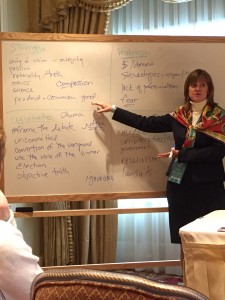
Strategic planning can be individually implemented within families or group organizations and generate overall success. Those who support traditional families can use planning tools to advocate for their cause when they develop a mission and vision.
Susan Yoshihara, director of the International Organizations Research Group Center for Family and Human Rights (C-Fam), presented a workshop that outlined strategic plans everyone can implement into their personal and professional lives.
Her strategic plan outline consisted of four main points: vision, mission, values and goals.
Vision is where you want to be. It is vivid, exciting, easily understood and simple. Yoshihara used her brother’s vision as he left on his last military deployment as an example.
“I’m going to stand at the brow of that ship, I’m going to shake the hands of every one of my troops, and I’m going to watch them run into the arms of their families,” Yoshihara said.
A mission is specific purpose for vision.
“Mission is like a laser beam, focused on a specific point,” Yoshihara said. She shared the mission of C-Fam: to “restore international law” by discrediting “socially radical policies.”
“We want someone to walk into a debate where the subject of abortion comes up and everyone laughs. We want the subject of different types of families to come up and people scoff, acknowledging how ridiculous the idea is,” Yoshihara said.
Values are the steps that carry out mission and vision. Yoshihara recommended picking three to five values that will be applied to everyone that is working toward the achievement of vision. Values can be professionalism, truth, compassion, excellence, collaboration and accountability.
Values intersect with goals and objectives and should include the SMART outline to make goals achievable. SMART stands for specific, measurable, achievable, realistic and time-bound. Goals using the SMART outline breakdown vision, mission and values into manageable bits.
Building a vision with mission, values and goals is desirable, but Yoshihara emphasized building that vision to endure the test of time.
“Some leaders don’t build their organizations to last. You want to be the best and be known as the best,” Yoshihara said.
Knowing threats and obstacles will aide in avoiding failure, and will assist in keeping individuals on a road to success.
“Be disciplined in action. Hold yourself to the highest standards to be your very best. We have to remember that God put us here to create a great plan that will help us reach our visions,” Yoshihara said.




